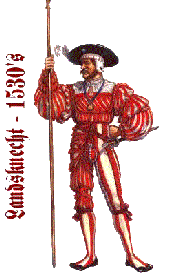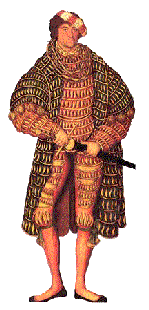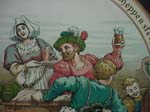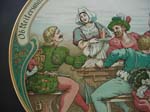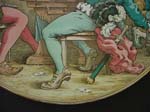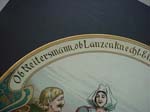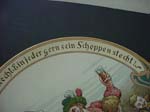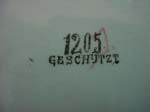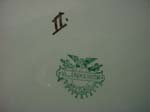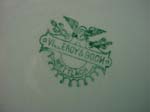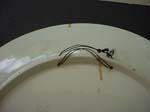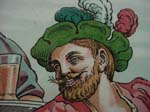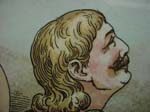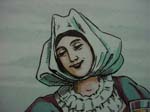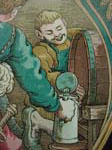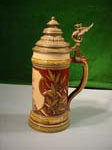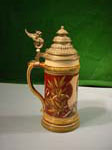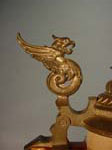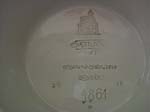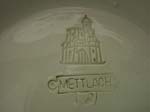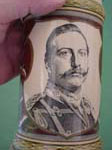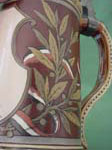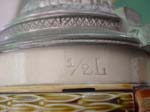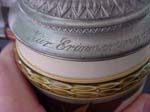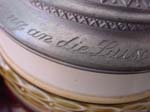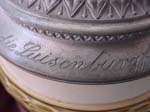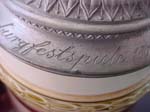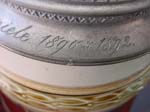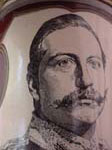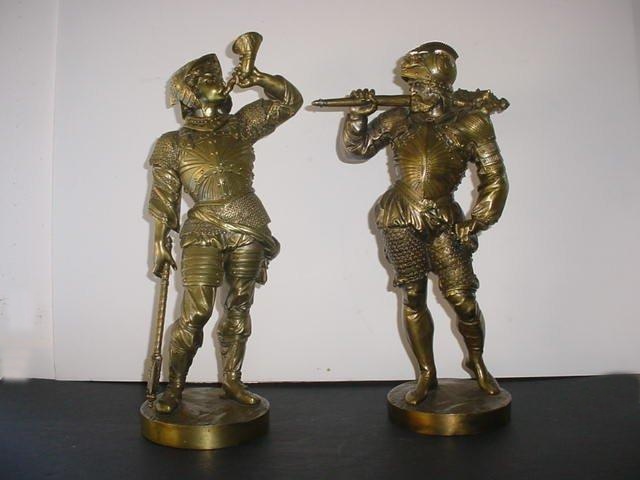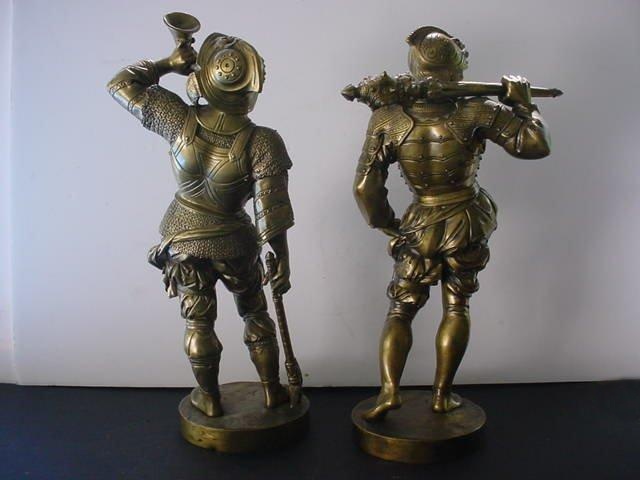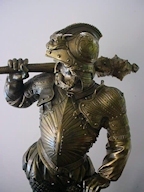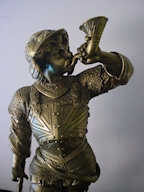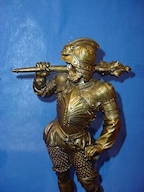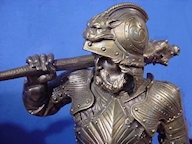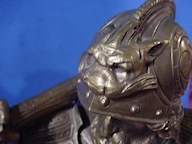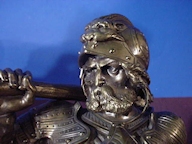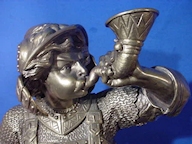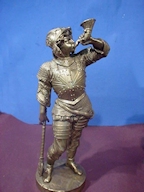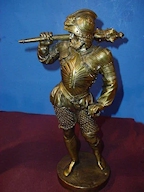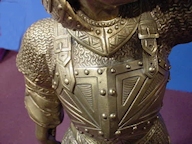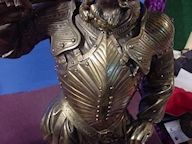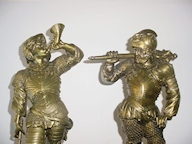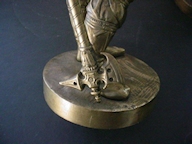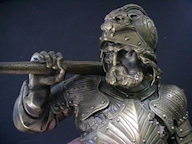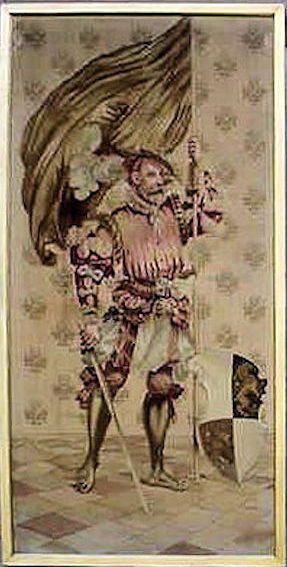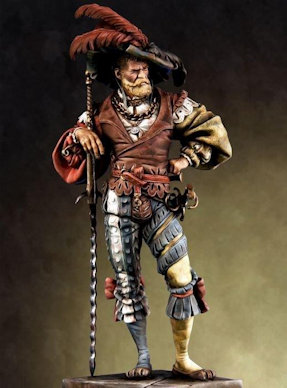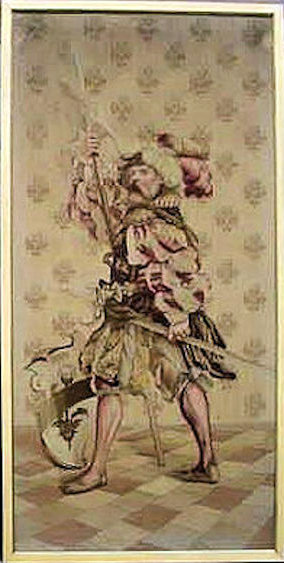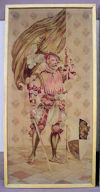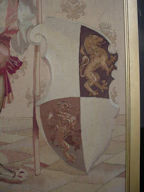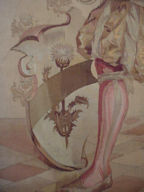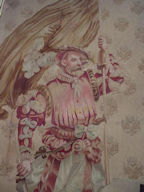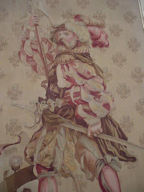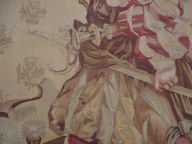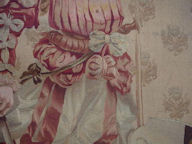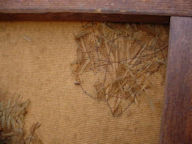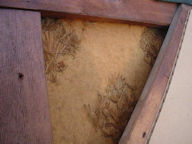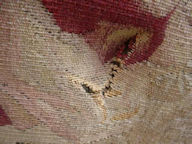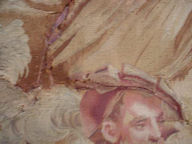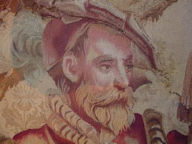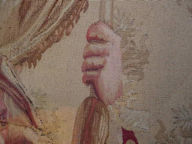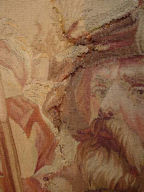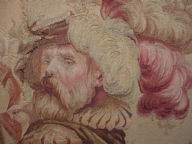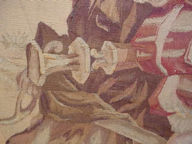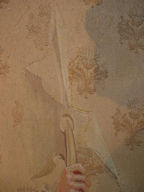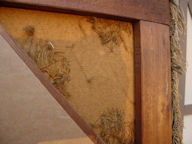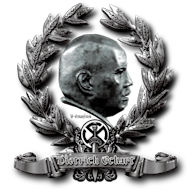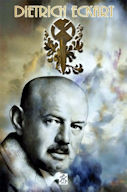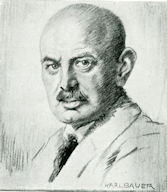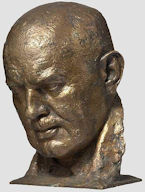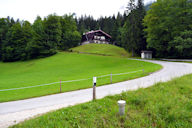|
|
|
|
Landsknechte
Page 2
|
|
|
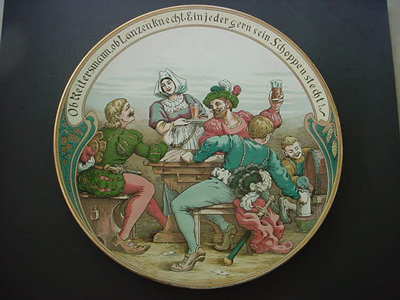 |
Mettlach Cameo Plaque Depicting Landsknecht Scene (Huge Collector’s Plate) (Item LAND 2-1 & KSTEIN 2-6) |
||
DESCRIPTION: This is a wonderful cameo plaque with the German mercenary freebooters known as Landsknecht depicted. Always considered the greatest and best of steins, the chargers are even more rare and beautiful. Mettlach is actually a town in Germany where the firm of Villeroy & Boch was founded in 1941. With the merging of three German factories, three of which had been established in the 18th century, The amalgamated company had its headquarters in Mettlach, Germany, which was the location of what was their most famous factory. The name Mettlach is derived from Latin for “mid-lakes” and in 1936 Nicholas Villeroy and Eugene Boch joined forces and formed a company producing masterpieces of steinware. They used the name of the town as their logo. The produced plates, vases, beer steins, etc., that were all state of the art. They were the largest and most important ceramic enterprise since the 19th century. The very colorful plate that we offer has a diameter of 17 ½” and depicts three of these freebooters gaily celebrating while drinking the “suds.” Beer was the favorite of the Landknecht warriors and they consumed barrels of it between battles. A maid and her little boy dispense the hops and malts to the guzzlers, and across the top is a scroll that says basically “Oh riders, O Landsknecht, every one gladly shares a pint.” The plate was probably produced in the 1870’s and is in great condition with a few slight age cracks. The cracks are in the surface and do not go through. It’s probably not even accurate to call them cracks at all. This is one beautiful art object from Alte Deutschland. PRICE: $850.00 |
||
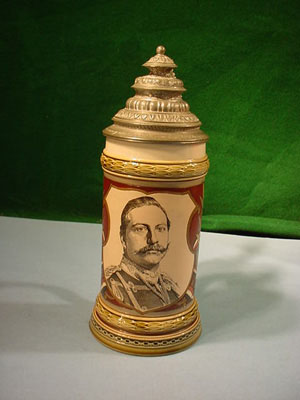 |
Mettlach Stein Commemorating Kaiser Wilhelm II (Item LAND 2-2 & KSTEIN 2-7) |
|||
DESCRIPTION: This is a very handsome beer stein by the famous Villeroy and Boch (Mettlach firm). Read more about it in the narrative about the plate featured above. The stein has the Mettlach Geslutz (patent) on the bottom with the Mettlach logo of the castle. The number is 1861 (not a date). The design has the picture of the young Emperor depicted in his uniform of the Royal Hussars. At the sides are the laurel leaves with the national colors – black, white, red – running in ribbon form in and out of the leaves. The thumblift is fashioned in the form of a griffen. The stein measures 10” from top to bottom. The colors are vivid and the pewter parts are perfect. A wonderful relic of the better era. Kaiser Wilhelm, where are you now that we need you? Around the edges of the pewter top is an engraved narrative. It basically says: “In memory of the Luisenburg-festspiele 189 to 1892.” A festspiele is a set of games such as football, archery, boating, tennis, etc. PRICE: $680.00 |
|||
|
|
|
Pair of Exquisite Bronze Statues of Landsknechte (Item LAND 2-3; BRONZEMET 3-1) |
DESCRIPTION: Here is a beautiful statuary group depicting two rough-and-ready mercenary soldiers known as Landsknechte.
For a further explanation of the term see the heading at our Landsknechte page at the top. These bold fighters usually wore colorful attire with flashing colors in the finest of fabric, but as they were the ultimate fighting men of their day the battle clothing changed from time to time as required by conditions, and also changed, depending on which king or noble lord they served and his requirements they conformed to. The two Landsknechte depicted here are in full armor—at least in the upper body. The helmets were of the style used by Soldaten who were in the employ of royalty or at least very wealthy landed gentry. Helmets such as this were extremely expensive in that era and both look to be the type crafted by metal masters in Italy. One man carries one of the most formidable weapons used by the mercenaries; a huge mace with its business end studded with sharp nail points. The other has a sword and he sounds a call to battle on his horn. The Landsknechte were proud fighting men and a very colorful lot having left behind a rich although bloody tradition. They had a series of battle ballads some of which are cataloged in German and Swiss archival records today. Some of their songs were sung by the storm troopers of the Third Reich; both Brown Shirts and army and Waffen- troops as they marched off to war. The sculptures are of pure bronze with a golden hue; they measure 16 ½ inches high and are quite heavy. The sculptures are not signed but are of the finest of quality. They must have been accomplished by a master sculptor who might have been so famous in his time that he felt his work was his signature alone. Imagine these stalwart battle-hardened fellows on your shelf or desk. They will surely be a statement of determination and will. troops as they marched off to war. The sculptures are of pure bronze with a golden hue; they measure 16 ½ inches high and are quite heavy. The sculptures are not signed but are of the finest of quality. They must have been accomplished by a master sculptor who might have been so famous in his time that he felt his work was his signature alone. Imagine these stalwart battle-hardened fellows on your shelf or desk. They will surely be a statement of determination and will.
PRICE: $2,500.00 for the set |
|
|
|
|
|
Two Landsknecht Tapestries from the Home of Dietrich Eckart, Connoisseur of the Arts (Item LAND 2-4; PERS 7-2; ART 18-5) |
|
DESCRIPTION: These two fantastic hand-woven tapestries once graced the walls of the Berchtesgaden Bavarian home of the man that Adolf Hitler called his mentor; this was Dietrich Eckart (1868-1923). Eckart began his career as a journalist and poet. He blamed his earlier lack of success on the Jews and Marxists. He also blamed the socialists for Germany’s defeat in WWI and in 1918, entered politics and created one of his several poems—the battle cry “Deutschland Erwache!” (“Germany Awake!”). Eckart was an early member of the German Workers’ Party that evolved into the National Socialist Workers’ Party (Nazi Party). He began a close friendship with Adolf Hitler and introduced the awkward, young politician to the “right” people in Munich. He also encouraged Hitler in his political agendas and nationalist aspirations. Eckart’s “Storm Song” was the oldest national hymn of the N.S. Party. In a pamphlet published shortly before his death, Eckart hailed Hitler as the man who would reveal the whole conspiracy of the left. (He often said that Moses was the first Bolshevist.) Eckart was in essence the father of the N.S. Party and for a time he did “awaken” the Germans—they listened to him; at least in Munich, Haupstadt der Bewegung,” (Capital of the Movement) and after Hitler had made his mark, that city and all of Germany listened to Eckart’s protégé. Information passed to us from German historian sources lead us to believe that Herr Eckart was a lover of the arts. We do know that he was independently wealthy and enjoyed the art and music of the Germanic peoples throughout the ages. He loved and strongly identified with Henrik Ibsen’s Peer Gynt. His father was a royal notary and law counselor in Nuremberg and was independently wealthy. The father was a collector of the finest in objects d’art. Dietrich became a playwright in Berlin under the tutelage of Georg Graf von Hülsen–Haeseler. During this time Dietrich developed an ideology of what has to be termed “genius” (higher human strata) at one point based on earlier writings by Lanz von Liebenfes. He joined the Thule Society in 1913 and became politically active in 1915. He wrote the nationalist play “Heinrich der Hohenstauffe” (“Heinrich of the High Baptism”) in which he postulated a claim to world leadership for the German people. Much more about this man of destiny can be Googled, but please read between the lines. Political correctness does have a way with defamation. This was the man to whom Hitler dedicated the first volume of Mein Kampf. During all of this fantastic and colorful career he was known to have strong interests in the collecting of Germanic art, a favorite subject in which he indulged himself. There were various art objects that depicted German warriors: from the fighting men like Arminius the Liberator (commonly called “Hermann”) who defeated Roman legions in the Battle of the Teutoberg Forest in the year 9 A.D., to Frederick Barbarossa’s knights. But, especially, he adored the stories of the Germanic Landsknechte, the colorful mercenary soldiers who had a formidable reputation and were to become an important professional warlike force through the late fifteenth and sixteenth centuries. They consisted predominantly of German mercenary pikemen and supporting foot soldiers and they achieved the reputation for being the best universal soldiers for hire in early modern Europe. Landsknechte typically came from Swabia, Alsace, Tyrol, and the Rhineland. These two magnificent tapestries depicting typical German Landsknecht soldiers were taken from the villa of Dietrich Eckart in Berchtesgaden by an agent enlisted by the OSS, which eventually became the CIA. Locals in that picturesque Bavarian community tell us that this particular house is still in use by the CIA. We cannot offer any educated backup knowledge of this, but that is the rumor. This has been an incredible journey indeed and our information was supplied by the son of the now-deceased operative. We did not receive the tapestries from this man, but after we bought them from an antique dealer, we showed them in a private antique show. The son of this OSS official saw them and immediately approached us and identified the pieces as the very ones that his father had in his possession and later sold. The older gentleman had not even known at first that this was the house of Hitler’s mentor until he was filled in by senior staff officers who had such knowledge. There is no doubt whatever as to the location of the house, and it is well known to historians; I have seen it myself as have other military historians. It is still there: a very nice little Landhaus from which came these magnificent Landsknectsoldaten tapestries. The Tapestries The tapestries are rather large, and measured from inside the frame they are 5 feet x 2 1/2 feet. The frames are 1 ¼ inches wide and are what we would call “OK!” These magnificent European art objects deserve more elaborate framing and I am sure when the right collector or institution acquires them this might well be accomplished. When they were “liberated,” we believe they were in elegant frames, or so we are told, but because of the nature of the moment of “acquisition” the frames had to remain behind at the villa. As you can obviously see, the tapestries are still showing the incredible artwork used in their wonderful production and were, of course, hand produced using the weaving art form known as petit point, the finest woven art the world has ever seen. The normal way that human figures were done was by needle point. To accomplish anything like these two tapestries in petit-point weaving would be infinitely more difficult and in subjects as large as these would be a labor so arduous so as it would seem absolutely impossible. Certainly it could not and would not be accomplished today. We ask that you would just imagine the length of time, the considerable amount of years it would take to weave these two tapestries all by hand. If there would be a glimmer of doubt that this was entirely (Handarbeit) “handwork” one can look at the back and see where even the smallest detail is separately tied off by hand and again this is incredible petit point. The work is many times more tedious to do than needlepoint. Even If it had been the larger weave it still would have been worthy of museum display. Petit-point works are so extremely rare—especially when of antiquity. Most are in museums and in many cases they are considered national treasures. I believe these could and should fall into that category. It is certain that Herr Eckart did! The soldiers are just as elaborately ornamental as you could possibly imagine. They have a unique three-dimensional effect. The embellishments are ornately superb and the artist was very knowledgeable of the Landsknecht costuming, weaponry, and historical presence. No European museum curator could possibly portray these tough mercenary fighters better. The soldier on the right holds a pike that was the initial weapon of these cadres (pikemen). He also has the great two-handed sword that has come to be known worldwide as the Landsknecht sword, “Zweihänder.” He also wears the short sword known as the Katzbalger. Beside him is seen a shield that depicts a mountain flower. Actually this same flower is seen in over 70 depictions in the background of the tapestries each one hand woven individually into the entire scheme. The figure on the left has a rapier (heavy sword), and he wears in his belt the Swiss-style mercenary dagger that is what the Nazi SA dagger was modeled after in the Third Reich. Beside him you can see a shield bearing two rampant lions. Both men are dressed in extremely exuberant costumes as Landsknechts always wore. It was the historical signature of the mercenary profession in that turbulent time. It seemed to be the rule that if a soldier was very handsomely attired, the more he had a genuine appeal to those who sought to hire him. We must note that these artworks are very handsome to an exceedingly intense degree and surely are without a doubt two distinct treasures of the Western world. Now comes the rather disappointing part. After these two tapestries were framed and set to be featured in a high-art auction, there came a time that they were sadly set in a place in the auction house where they shouldn’t have been. This was inexcusable and one tapestry was actually lying on top of the other and then tragedy struck! There was a large paper tarp placed over them to keep them clean and their being in that location was to be very temporary, but in the hectic goings-on there on that day, along came a stock attendant and seeing the white paper he thought it to be a table top and he placed an extremely heavy object right on top and needless to say this object plunged right through the precious tapestries like a knife through butter–tragic? Most certainly! Did they lose all value? NO! They still are what they are. Did they lose very significant value? YES! The reserve price of these fantastic items was simply astounding. The insurance settlement was even more than astounding. Later, we were offered them and after seeing them we just had to have them. Why? Because of all we have said about them in this essay we still truly feel they are extremely important historical items and possess sheer beauty and to us the fact that they were owned by one of German history’s most important and possibly most infamous individuals does give them some significant additional prestige. However, they do stand on their own as what I can only describe as masterpieces of the weaver’s art. The damage is very noticeable when looking at them close up and a more professional repair could make them fairly whole again, but it would necessitate finding an artist who would be able to duplicate the Old World skills and frankly we do not think anyone today would be in the least capable of this. (*Our opinion). The damage is as follows: the tapestry on the right in our pictures has a gash from the bottom of the pike’s point and blade down to the hat of the man’s head and down along the outside area along the man’s face, but incredibly missing the face–thank goodness! It continues for a short distance along the sleeve of the costume. The gash on the figure on the left begins at the top of the banner and travels down through the ensign and then proceeds both right and left and then surrounds the large white hat plume and the Landsknecht hat and down to the pom-pom decoration in the center of the standard. After tracing along on the hat plume it travels about nine inches into the background and by some miracle it also missed the face. The repair that was attempted looks rather crude, but when one looks at the figures straight on, the repairs are not quickly noticeable. They are still of such a quality that any trained eye that will appreciate such excellence might just forgive their past misfortune. It is beyond incredible that the faces were missed in the horrid accident. Remember Venus de Milo is missing her arms and Nefertiti lost an eye, but they are still loved and adored. These tapestries will without a doubt end up being a prized display in a museum, someday. In the meantime, we enjoy the privilege of stewardship. Congratulations Dietrich Eckart for having owned them. Deutschland Erwache! PRICE: Price on request: Serious inquiries only, please |
Page Two |
Please refer to item designator in parentheses in all correspondence.
Please E-mail for any additional information you may need.If you prefer, contact 'Germania' at PO Box 68, Lakemont, GA 30552
or call at 706.782.1668.
Please! do not call during the wee hours of the morning. The best time for calling us is between 9 and 11 am and between 9 and 11 pm eastern time.


